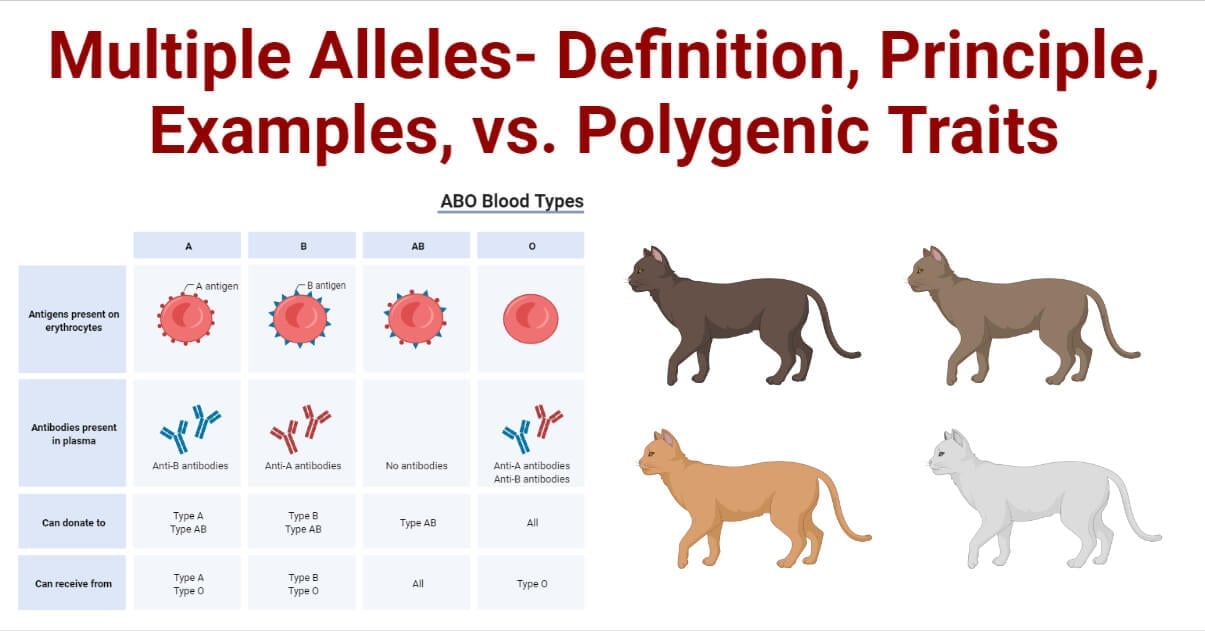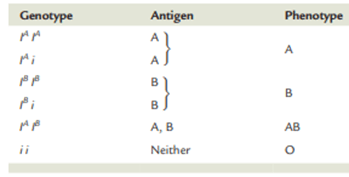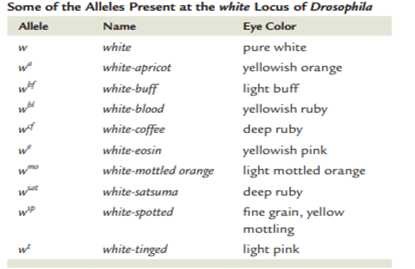The different variants of a gene located at the same location on homologous chromosomes are known as alleles or allelomorphs. Multiple alleles refer to genes that have more than two allelic forms.

- A haploid cell only has one allele, while a diploid cell might have either of the two alleles present on each homologous chromosome.
- Multiple allelism is the term used when more than one allele controls a characteristic. A gene may have many alleles that reside at the same chromosomal location.
- As different expressions of the same gene, multiple alleles affect the same trait.
- The wild-type allele predominates over the mutant alleles in most cases. All other alleles are viewed as variations of the wild type, which is the accepted norm.
- The mutant or variant allele may have an intermediate influence on phenotype or be either dominant or recessive.
- At the population level, there are several alleles, but an individual can only have two alleles for a specific gene.
Interesting Science Videos
Multiple Allele in a Population
Heterozygous means a person has two different alleles, whereas homozygous means they only have one type of allele. There may be many mutant alleles in a population. They arise from an unintentional mutation in both the wild type and the mutant alleles. Multiple alleles exist in a population when there are many variations of a gene present. In diploid organisms, each organism has the ability to express two alleles at the same time. Haploid organisms and cells only have one copy of a gene, but the population can still have many alleles.
Mutations and Multiple Alleles
Mutations can cause a different sequence of nucleic acid bases in the DNA, either in a simple or drastic way. Mutations can lead to novel forms of protein, which can allow organisms to develop new pathways, structures, and functions. Humans have over 3 billion base pairs, and mutations in any base pair can cause a new allele. Multiple alleles combine in different ways in a population, producing different phenotypes. This is the basis of natural selection, where new mutations arise and new lines of genetics are born.
Characteristics of Multiple Alleles
- When there are more than two different variants of a gene at a certain locus, multiple alleles, a type of genetic diversity, appear.
- Multiple alleles can result in a variety of combinations, as opposed to two alleles, where there are only two possible combinations.
- This opens up the possibility for a broad variety of phenotypic features, including blood type, eye colour, and hair colour.
- The ABO blood type system used by people is one of the most well-known examples of multiple alleles.
- Three alleles, A, B, and O, make up the ABO system. Specific glycoproteins found on the surface of red blood cells are encoded by these alleles.
- The O allele does not code for any antigen, while the A allele does for the A antigen, the B allele does for the B antigen, and so on. Because the A and B alleles are codominant, both antigens will be expressed on a person’s red blood cells if they inherit one of each.

Pleiotropy
Pleiotropy refers to the phenomenon in which one gene influences several attributes, wherein one allele may cause a variety of phenotypic features in several alleles. This is possible because a gene may produce a protein or RNA molecule that functions in several cellular or metabolic pathways. As a result, modifications to the gene sequence may affect a variety of biological functions, producing pleiotropic effects.
The gene that causes sickle cell anaemia is one instance of pleiotropy. This gene produces the haemoglobin protein, which is in charge of transporting oxygen in red blood cells. However, a gene mutation causes an abnormal form of haemoglobin to be produced in people with sickle cell anaemia. A number of health issues might result from the red blood cells’ irregular shape and adhesion due to this aberrant haemoglobin. It is believed that this mutation survives in some groups because it also confers some resistance to malaria.
Comparison with Pseudo- And Isoalleles
Other forms of genetic diversity that might be mistaken with numerous alleles include pseudoalleles and isoalleles.
Pseudoalleles
- Pseudoalleles are caused by mutations in a gene’s regulatory regions, which can change a gene’s expression without changing the protein sequence.
- The promoter of the lactase gene, which produces the enzyme responsible for breaking down lactose in milk, is an illustration of a pseudoallele.
- Lactose intolerance is caused in certain groups by a mutation in the lactase promoter region.
- The lactase gene’s expression is impacted by this mutation, which reduces the body’s capacity to digest lactose.
Isoalleles
- Isoalleles, on the other hand, are alleles with the same function but distinct DNA sequences.
- Isoalleles, on the other hand, result from mutations that have no impact on the protein’s functionality.
- The function of the protein is unaffected by these mutations, which can happen in non-coding sections of the gene like introns or regulatory regions.
- Isoalleles differ in DNA sequence but are functionally equivalent to one another.
On the other hand, distinct alleles of the same gene that code for various versions of a protein or RNA molecule are known as multiple alleles. Multiple alleles can produce various phenotypic traits, in contrast to pseudoalleles and isoalleles.
Penetrance
The percentage of people with a specific genotype who display the predicted phenotype is known as penetration. Some multiple alleles exhibit incomplete penetrance, meaning that only a portion of people with a given genotype shows the predicted phenotype. This may happen as a result of the existence of modifier genes or environmental elements that affect the gene’s expression. The gene for polydactyly, which results in additional fingers or toes, is one instance of incomplete penetrance. Because polydactyly is inherited in an autosomal dominant manner, it only requires the presence of one copy of the mutant allele to manifest. Not every person who carries the mutant gene, nevertheless, will have polydactyly. This is due to the mutant allele’s imperfect penetrance, which means that not every person with the genotype would exhibit the desired phenotype.
Expressivity
The expression describes the strength or extent of a trait linked to a certain genotype. Multiple alleles with variable expressivity allow the phenotype brought on by a given genotype to change in strength or severity.
- Gene expression variations, environmental influences, or genetic modifiers may all contribute to this.
- The gene in charge of neurofibromatosis type 1 (NF1) is an illustration of variable expressivity.
- NF1 is an autosomal dominant condition that causes benign tumours to grow on nerve tissue. Even among people with the same genotype who have the condition, the quantity and severity of tumours can vary greatly.
- This is due to the varying NF1 gene expressivity and the variable degree or severity of the condition linked to the gene.
- Multiple alleles are a type of genetic variation that can produce a wide variety of phenotypic traits, to sum up.
- Multiple alleles are characterized by pleiotropy, incomplete penetrance, and variable expressivity, among other characteristics.
- Deciphering the genetic basis of human disease and creating efficient treatments and cures depend on our ability to comprehend the complicated interactions between genotype and phenotype.
Examples of Multiple Alleles
Multiple alleles are common in all organisms, including plants, animals, and humans. Here are some common examples of multiple alleles in each group.
Multiple Alleles in Plants
There are at least four alleles in the multiple allele system that determines flower colour in snapdragons: W (white), R (red), P (pink), and I (intermediate).
- Plants with two copies of the W allele have white flowers because it is dominant over all other alleles.
- Due to the codominance of the R and P alleles, individuals who carry one copy of each have flowers that are spotted with both red and pink.
- All other alleles are recessive to the I allele, which results in intermediate colours. People who have two copies of I have intermediate-coloured flowers as a result.
- The snapdragon population may display a broad variety of flower colours and patterns because of its multiple allele system.
- At least three alleles—W (white), Y (yellow), and R (red)—are involved in the multiple allele system that determines the colour of the bean seed coat.
- Plants that carry two copies of the W allele, which is dominant over all other alleles, have white seed coats. Individuals with one copy of each of the Y and R alleles have seed coats that are flecked with both yellow and red because they are codominant alleles.
- The bean population may exhibit a broad diversity of seed coat hues and patterns because of this multiple allele system.
Multiple Alleles in Animals
There are at least four alleles in the multiple allele system that determines the coat colour of rabbits: CC (full colour), cch (chinchilla), chd (Himalayan), and cc (albino).
- Rabbits who have two copies of the C allele, which is dominant over all other alleles, have full-colour coats.
- Individuals with one copy of each of the codominant cch and chd alleles have coats that are flecked with both chinchilla and Himalayan colours.
- All other alleles are recessive to the c gene, which results in albino coats. As a result, those with two copies of gene c have albino coats.
- The rabbit population can have a vast variety of coat colours and patterns because of this multiple allele system.

Multiple Alleles in Humans
The complicated and poorly known multiple gene systems governing eye colour. At least two genes, OCA2 and HERC2, are known to affect eye colour, and it is known that these genes interact with one another and with other genes to cause distinct eye colours. The HERC2 gene controls the expression of OCA2, and the OCA2 gene generates a protein that aids in the transfer of melanin, the pigment that gives the eyes their colour. The quantities and kinds of melanin produced by various variants of these genes can result in a variety of eye colours.
A collection of genes known as the HLA genes are essential for the immune system to identify and react to foreign invaders like viruses and bacteria.
- Each HLA gene can have several alleles, and there are numerous distinct HLA genes.
- An individual’s capacity to identify and react to various kinds of foreign substances, as well as their susceptibility to particular diseases, can be affected by different combinations of these alleles.
- For instance, autoimmune disorders like type 1 diabetes and rheumatoid arthritis are more likely to occur in people with specific combinations of HLA alleles.
As a whole, these illustrations highlight the significance and adaptability of numerous alleles in determining the genetic diversity and variety of populations of plants, animals, and people. A population with several alleles can exhibit a wide range of phenotypic variation, which can be useful for coping with environmental change and preserving genetic variety. The intricate nature of genetic inheritance and the necessity for continued study are further highlighted by the intricacy and diversity of multiple allele systems.
Multiple Alleles vs. Polygenic Traits
| Multiple alleles | Polygenic traits |
| Two or more alternate forms of the same gene | Controlled by a group of non-allelic genes |
| Present on same DNA strand | Found on multiple DNA strands |
| Unaffected by environmental factors | Affected by environmental factors |
| Trait determination by co-dominance or complete dominance | Trait determination by co-dominance or incomplete dominance |
| There is no homologous crossing over | Between two alleles of each polygene, homologous crossing over can take place |
| Responsible for qualitative traits | Responsible for quantitative traits. |
| Multiple alleles found in the population | Polygenic traits found in individual |
| E g: ABO blood grouping, white gene locus in drosophila, cat coat color, HLA gene | E g: kernel color in wheat |
Conclusion
The study of multiple alleles has significant implications for fields such as population genetics, evolutionary biology, and personalized medicine. By studying the distribution of multiple alleles across populations, researchers can gain insights into human evolutionary history and migration patterns. In personalized medicine, the study of multiple alleles can help identify genetic variations that increase the risk of disease or influence how an individual responds to treatment. However, the presence of multiple alleles can make it difficult to predict an individual’s phenotype based on their genotype accurately. It can complicate genetic counseling for individuals and families affected by genetic diseases. Despite the challenges they pose, multiple alleles offer valuable insights into the relationship between genotype and phenotype and are critical for understanding the genetic basis of human disease and development.
References
- Biologydictionary.net Editors. “Multiple Alleles.” Biology Dictionary, Biologydictionary.net, 06 Dec. 2016, https://biologydictionary.net/multiple-alleles/.
- https://courses.lumenlearning.com/wm-biology1/chapter/reading-multiple-alleles/
- Hartl, Daniel L., and Elizabeth W. Jones. Genetics: analysis of genes and genomes. Jones & Bartlett Learning, 2009.
- Strachan, T., & Read, A. P. (2010). Human molecular genetics. Garland Science.
- Griffiths, A. J., Miller, J. H., Suzuki, D. T., Lewontin, R. C., & Gelbart, W. M. (2000). An introduction to genetic analysis. W.H. Freeman.
